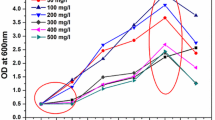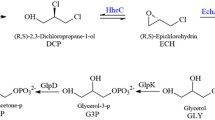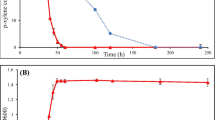Abstract
The stability of Pseudomonas putida F1, a strain harbouring the genes responsible for toluene degradation in the chromosome was evaluated in a bioscrubber under high toluene loadings and nitrogen limiting conditions at two dilution rates (0.11 and 0.27 h−1). Each experiment was run for 30 days, period long enough for microbial instability to occur considering previously reported studies carried out with bacterial strains encoding the catabolic genes in the TOL plasmid. At all tested conditions, P. putida F1 exhibited stable performance as shown by the constant values of the specific toluene degradation yield, CO2 produced versus toluene degraded yield, and biomass concentration within each steady state. Benzyl alcohol, a curing agent causing TOL plasmid deletion in Pseudomonas strains, was present in the cultivation medium as a result of the monooxygenation of toluene by the diooxygenase system of P. putida F1. However, no mutant population growing at the expense of the extracellular excreted carbon or lysis products was established in the chemostat as confirmed by the constant dissolved total organic carbon (TOC) concentration and fraction of toluene degrading cells (approx. 100%). In addition, batch experiments conducted with both lysis substrate and toluene simultaneously confirmed that P. putida F1 preferentially consumed toluene rather than extracellular excreted carbon.





Similar content being viewed by others
References
American Public Health Association (1995) Standard methods for the examination of water and wastewater. American Public Health Association, Washington, D.C
Bordel S, Diaz LF, Muñoz R, Villaverde S (2007) New insights on toluene biodegradation by Pseudomonas putida F1: influence of pollutant concentration and excreted metabolites. Appl Microbiol Biotechnol 74:857–866
Davison CT, Daugulis AJ (2003) Addressing biofilter limitations: a two-phase partitioning bioreactor process for the treatment of benzene and toluene contaminated gas streams. Biodegradation 14:415–421
Duetz WA, Winson MK, van Andel JG, Williams PA (1991) Mathematical analysis of catabolic function loss in a population of Pseudomonas putida mt-2 during non-limited growth on benzoate. J Gen Microbiol 137:1363–1368
Ensley BD, Kurisko PR (1994) A gas lift bioreactor for removal of contaminants from the vapor phase. Appl Environ Microbiol 60:285–290
García Peña EI, Hernandez S, Favela Torres E, Auria R, Revah S (2001) Toluene biofiltration by the fungus Scedosporium apiospermum TB1. Biotechnol Bioeng 76(1):61–69
Gibson DT, Hensley M, Yoshioka H, Marbry TJ (1970) Formation of (+)-cis-2,3-dihydroxy-1-methylciclohexa-4,6-diene from toluene by Pseudomonas putida. Biochem-US 9:1626–1630
Harding RC, Hill GA, Lin YH (2003) Bioremediation of toluene-contaminated air using an external loop airlift bioreactor. J Chem Technol Biotechnol 78:406–411
Jenkins RO, Heald SC (1996) Stability of toluene oxidation by Pseudomonas putida under nutrient deprivation. Appl Microbiol Biotechnol 46:388–392
Keshavarz T, Lilly MD, Clarke PH (1985) Stability of a catabolic plasmid in continuous culture. J Gen Microbiol 131:1193–1203
Koutinas M, Peeva LG, Livingston AG (2005) An attempt to compare the performance of bioscrubbers and biotrickling filters for degradation of ethyl acetate in gas streams. J Chem Technol Biotechnol 80:1252–1260
Jones WL, Mirpuri RG, Villaverde S, Lewandowski Z, Cunningham AB (1997) The effect of bacterial injury on toluene degradation and respiration rates in vapor phase bioreactor. Water Sci Technol 36(1):85–92
Leddy MB, Phipps DW, Ridgway HF (1995) Catabolite-mediated mutations in alternate toluene degradative pathways in Pseudomonas putida. J Bacteriol 177(16):4713–4720
Lee SG, Strand SE, Stensel HD (2000) Sustained degradation of trichloroethylene in a suspended growth gas treatment reactor by an actinomycetes enrichment. Environ Sci Technol 34:3261–3268
Mirpuri RG, Jones W, Bryers JD (1997) Toluene degradation kinetics for planktonic and biofilm-grown cells of Pseudomonas putida 54G. Biotechnol Bioeng 53(6):535–546
Neal AB, Loehr RC (2000) Use of biofilters and suspended growth reactors to treat VOCs—the role of humidity and microbial heat generation. Waste Manage 20(1):59–68
Nielsen J, Villadsen J, Lidén G (2003) Scale-up of bioprocesses. In: Nielsen J, Villadsen J, Lidén G (eds) Bioreaction engineering principles, 2nd edn. Kluwer Academic/Plenum Publishers, New York
Oliveira TAC, Livingston AG (2003) Bioscrubbing of waste gas-substrate absorber to avoid instability induced by inhibition kinetics. Biotechnol Bioeng 84(5):552–563
Revah S, Morgan-Sagastume JM (2005) Methods for odor and VOC control. In: Shareefdeen Z, Singh A (eds) Biotechnology for odour and air pollution, Springer-Verlag, Heidelberg, Germany
Shareefdeen Z, Singh A (2005) Biotechnology for odour and air pollution. Springer-Verlag, Heidelberg, Germany
Song JH, Kinney KA (2005) Microbial response and elimination capacity in biofilters subjected to high toluene loadings. Appl Microbiol Biot 68:554–559
Tresse O, Lescob S, Rho D (2003) Dynamics of living and dead bacterial cells within a mixed-species biofilm during toluene degradation in a biotrickling filter. J Appl Microbiol 94:849–855
U.S. EPA (1994) Ranking of pollutants with respect to human health. Technical background document to support rulemaking pursuant to clean air. Act section 112 (g). US Environment Protection Agency, Research Triangle Park, N.C
U.S. EPA (1996) Priority pollutants. Code of federal regulations. Title 40, Chapter 1, Part 423, Appendix A U.S. Environmental Protection Agency, U.S. Government Printing Office, Washington, D.C
van Groenestijn JW, Kraakman NJR (2005) Recent developments in biological waste gas purification in Europe. Chem Eng J 113:85–91
Villaverde S, Mirpuri RG, Lewandowski Z, Jones WL (1997a) Physiological and chemical gradients in a Pseudomomas putida 54G biofilm degrading toluene in a flat plate vapor phase bioreactor. Biotechnol Bioeng 56:361–371
Villaverde S, Mirpuri RG, Lewandowski Z, Jones WL (1997b) Study of toluene degradation kinetics in a flat plate vapor phase bioreactor using oxygen microsensors. Water Sci Technol 36:77–84
Villaverde S, Fernández MT (1997) Non-toluene associated respiration in a Pseudomonas putida 54G biofilm grown on toluene in a flat plate vapor phase bioreactor. Appl Microbiol Biot 48:357–362
Wang J-L, Chen W-L, Lin YH, Tsai C-H (2000) Cryogen free automated gas chromatography for the measurement of ambient volatile organic compounds. J Chromatogr A 896:31–39
Williams PA, Taylor SD, Gibb LE (1988) Loss of the toluene/xylene catabolic genes of TOL plasmid PWWO during growth of Pseudomonas putida on benzoate is due to selective growth advantage of ‘cured’ segregants. J Gen Microbiol 134:2039–2048
Zilli M, Del Borghi A, Converti A (2000) Toluene removal vapor in a laboratory-scale biofilter. Appl Microbiol Biot 54:248–254
Zylstra GJ, McCombie WR, Gibson DT, Finette BA (1988) Toluene degradation by Pseudomonas putida F1: genetic organization of the tod operon. Appl Environ Microb 54(6):1498–1503
Acknowledgements
This research was supported by the Spanish Ministry of Education and Science (PPQ2006-08230 and JCI-2005-1881-5 contracts). Dr. J. M. Bueno and Araceli Crespo are gratefully acknowledged for their practical assistance.
Author information
Authors and Affiliations
Corresponding author
Rights and permissions
About this article
Cite this article
Díaz, L.F., Muñoz, R., Bordel, S. et al. Toluene biodegradation by Pseudomonas putida F1: targeting culture stability in long-term operation. Biodegradation 19, 197–208 (2008). https://doi.org/10.1007/s10532-007-9126-6
Received:
Accepted:
Published:
Issue Date:
DOI: https://doi.org/10.1007/s10532-007-9126-6




